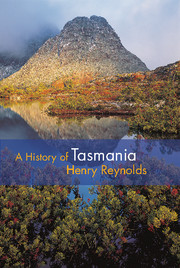Book contents
- Frontmatter
- Contents
- Illustrations
- Acknowledgements
- Introduction
- 1 First Meetings, Extraordinary Encounters
- 2 Van Diemen's Land: Settling in the enviable island
- 3 The Black War: The tragic fate of the Tasmanian Aborigines
- 4 An Indelible Stain?
- 5 The Triumph of Colonisation
- 6 The Politics of Van Diemen's Land
- 7 The Convict System
- 8 Post-penal Depression, 1856–70
- 9 Reform and Recovery
- 10 Federation and War
- 11 Between the Wars
- 12 Postwar Tasmania
- 13 Towards the Bicentenary
- Notes
- Sources
- Index
1 - First Meetings, Extraordinary Encounters
Published online by Cambridge University Press: 05 April 2012
- Frontmatter
- Contents
- Illustrations
- Acknowledgements
- Introduction
- 1 First Meetings, Extraordinary Encounters
- 2 Van Diemen's Land: Settling in the enviable island
- 3 The Black War: The tragic fate of the Tasmanian Aborigines
- 4 An Indelible Stain?
- 5 The Triumph of Colonisation
- 6 The Politics of Van Diemen's Land
- 7 The Convict System
- 8 Post-penal Depression, 1856–70
- 9 Reform and Recovery
- 10 Federation and War
- 11 Between the Wars
- 12 Postwar Tasmania
- 13 Towards the Bicentenary
- Notes
- Sources
- Index
Summary
What extraordinary encounters they were. Few human beings can have known the awe and wonder experienced by the Tasmanians living on the island's southeast coast during the last quarter of the 18th century. In common with other Tasmanians, they had lived in isolation from the rest of the world, since the time when Bass Strait flooded at least 8000 years earlier. Some memory of migration from the distant mainland may have survived as legend but for over 300 generations Tasmania was their all-embracing world, fellow islanders the only known inhabitants of the universe, their ways the time honoured pattern for the whole of humankind.
Suddenly, dramatically, it all changed. Nothing would ever be the same again. The brief visit of Tasman's two ships in 1642 had no sequel, although, between 1772 and 1802, 11 expeditions visited, explored and charted the much indented and complex coastline between Recherche Bay in the far south and the Freycinet Peninsula on the mid east coast. For European sailors Tasmania was a welcome haven, shelter from the prevailing westerly winds, with secure anchorages. It had a mild climate, broad beaches and access to timber and fresh water. Earnest navigators slipped lyrical passages about the island into otherwise prosaic log books and diaries. Even the unimaginative realised what an extraordinary impact their presence had on the coastal clans and understood how utterly exotic ordinary objects and everyday behaviour must have seemed to the Tasmanians. George Augustus Robinson was one of the few people to record the Tasmanians’ stories.
- Type
- Chapter
- Information
- A History of Tasmania , pp. 5 - 23Publisher: Cambridge University PressPrint publication year: 2011



